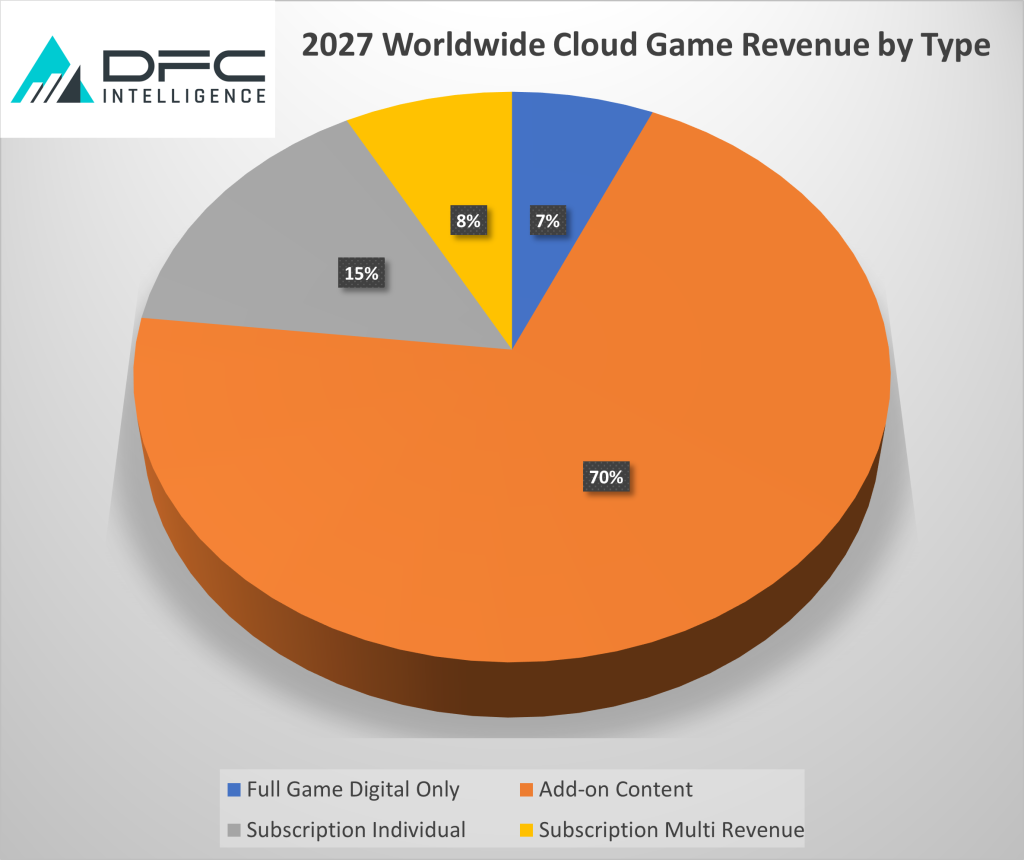DFC Intelligence believes that game streaming and cloud delivery will be one of the most important growth drivers for video games over the next several years. Streaming will enhance high-end client games and offer new ways for titles to expand over time and generate revenue on an ongoing basis. In addition, cloud delivery is actually expected to increase hardware sales. Overall DFC estimates that worldwide revenue from cloud games will reach $27 billion by 2027.
Overview
Cloud games and streaming has been a hot topic in the game industry for many years. Much of this has focused around the concept of a subscription streaming service that allows games to be played on any device. Large companies such as Amazon (Luna), Google (Stadia), NVIDIA (GeForce), Microsoft (Game Pass) and Sony (PlayStation Plus), have all delivered streaming game services.
The concept is that gamers are able to play without needing to own or upgrade consoles and PC game platforms. However, gamers have been slow to adopt the subscription model. Furthermore, long-term, subscription models are forecasted to be only a small portion of cloud game revenue.
Subscription Services and Games
The concept of a “Netflix of games” subscription model where consumers have access to hundreds of products has been thrown about for many years. However, content production and aggregation for games is not necessarily suitable for a subscription model. With traditional video, content comes in blocks and has no real interactive capability which is the opposite of what makes games a more unique and involved activity. Gamers play a single product for hours at a time, collaborate and compete.
Furthermore, the business model of subscription services is questionable. Games are a premium product and giving them away as part of a subscription service rarely makes economic sense. Plus, “free to play” models don’t work well behind paywalls. The best business model seems to be where consumers buy the actual games and use the service to play them without owning the necessary hardware.
In our testing the best streaming subscription service is Nvidia’s GeForce Now Ultimate. Ultimate is a $20 a month service that basically allows consumers cloud access to a PC with a GeForce RTX 4080 graphics card. Considering this card retails for well above $1,000, this is a good deal. It also fits nicely into the reality that most gamers only play a few key titles.

Add-On Content Drives Growth
In the latest DFC Intelligence forecasts, multi-game subscription services are expected to account for only about 10% of cloud game revenue over the next five years. The biggest driver of growth for cloud delivery is via add-on content that makes games living products that last for years. The concept of living games has been evolving for years but features like cloud delivery and Generative AI are taking products to the next level.
One of the best examples of cloud delivery for a high-end game is Microsoft’s Flight Simulator released in 2020. Flight Simulator is a client-side product that requires a high-end PC (or Xbox). However, cloud delivery and AI extend the game far beyond what even the highest-end consumer PC is capable of.
Flight Simulator was developed in part as a showcase for Microsoft’s Azure cloud service. A full article on the features can be found here, but basically Microsoft has created a digital twin of the entire world that can only be accessed via cloud delivery.

The map of the world used in Flight Simulator is 2.5 petabytes or 2.5 million gigabytes. In other words, it would take 2,500 Xbox Series X with a 1TB drive to store all the data in Flight Simulator. On top of that the cloud features of Flight Simulator include 37,000 airports, 2 million cities and more. Cloud delivery allows for real-time weather and AI can generate air traffic control communications. A consumer needs 150 GB of hard drive space for the initial installation of Flight Simulator. However, cloud delivery extends that experience by an order of magnitude.

The latest DFC Intelligence forecasts estimate that worldwide cloud games will reach $27 billion by 2027. Of that revenue 85% will be from add-on content or subscriptions to individual games such as Fortnite. Only a small percentage will come from replacing traditional game delivery. In other words, consumers will continue to buy products as they have in the past, but these games will be enhanced by cloud features that take them to the next level as they become living games.

